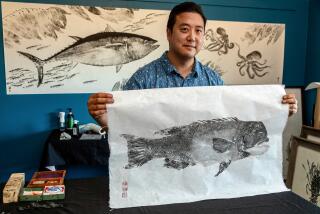Hooked on a-Reeling
- Share via
The joy of fly-fishing, enthusiasts argue with near-religious fervor, lies in that enigmatic area between art and nature.
It’s a borderline Zen experience, a direct connection from the soul to the line to the hand-tied fly to, finally, the fish, lurking somewhere in the shadows of a river eddy.
At William R. Mason Regional Park in Irvine, all the ingredients were there Saturday. Except for the river. And the flies, which hide the hooks, which would have been deadly weapons on the lines of some 25 novices who showed up to learn the art of casting.
“We’d have had a lot of free pierced ears,” explained Daniel Iwata, president of the 250-member Fly Fishers Club of Orange County, which sponsored Saturday’s annual free clinic. A separate clinic for women runs from 1 to 3 p.m. today. Parking is $4.
There’s something inherently comical about watching 25 people edge up to an artificial lake in the middle of a planned community to cast hookless fishing lines over and over again into water as murky as pea soup.
The irony was not lost on Saturday’s participants, who were there to learn the art of tricking a fish into thinking a piece of string and a feather are edible. So, for a few hours anyway, delusion ran rampant. A green-tinged pond in the heart of suburbia stood in place of a trout stream in Montana, and a tuft of orange yarn served as a hand-tied fly.
“It does take a lot of practice,” said Tim Hoops, 48, of Brea, a veteran angler but a recent convert to fly-fishing. “When you’re out on a stream, that’s all you can think about, the rod and fly and the fish. It’s getting back to nature, learning what a trout is likely to do.”
The key to casting is finesse, not strength. Distance and accuracy are the rewards of a light touch; a heavy hand plops the line at your feet. Timing is critical, keeping the line airborne as the rod is whipped forward, then snapped, like a drumstick on a cymbal, shooting the fly out over the water before it settles to the surface.
“Focus on the stop,” an unidentified instructor advised Hoops. “It approaches violence, but all the rest follows that.”
Saturday, the skills ran on a continuum from the plop-in-front to a graceful arc and nearly splashless landing. As Hoops and the others practiced, their brightly colored fishing lines spun overhead in a cloud of yellow, orange and red. Rod tips cut through the air with a soft, whispery whistle. Ducks and coots, confused by the spectacle, paddled to safety.
Fly-fishing has been around for centuries. It became an emblem of class and leisure in England in the 1600s. In the United States, it enjoyed steady popularity through the early 20th century but became more widely embraced after World War II, when fiberglass replaced the traditional and expensive bamboo as the rod-making material of choice. Still, rods can cost thousands of dollars, and good reels can cost several hundred.
After Robert Redford directed the 1992 movie based on Norman Maclean’s 1976 book, “A River Runs Through It,’ the sport picked up a romantic cachet. Suddenly, everyone wanted to hike into the mountains, twirl a line like a bullwhip and catch rainbow trout.
“The industry grew by about one-third a year since that time, as measured in business volume,” said Mark Christine of Newport Beach, who in June will become president of the Southwest Council of the sport’s major national association, the Federation of Fly Fishers. “It’s just a great excuse to get outdoors.”
George Peters, conservation director for the council, credits fly-fishing with drawing him to studying conservation issues and the history of development--particularly water use--in the West. And it has led him to travel to fish streams in Argentina and New Zealand, among other places. But the fishing itself, he said, carries its own rewards.
“They never put a fish in an ugly place,” said Peters, of Laguna Niguel.
As always among anglers, there’s a certain amount of bragging involved in fly-fishing.
“Being able to say I’m one of the first ones to throw a fly on this water--that’s an adrenaline shot,” said Iwata, who once traveled to Patagonia, in Argentina, just to catch trout. “There’s just a natural beauty to it, to visit these places.”
More to Read
Sign up for The Wild
We’ll help you find the best places to hike, bike and run, as well as the perfect silent spots for meditation and yoga.
You may occasionally receive promotional content from the Los Angeles Times.







